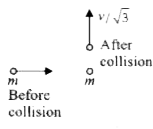A mass m moves with a velocity v and collides inelastically with another identical mass. After collision the 1st mass moves with velocity v√3 in a direction perpendicular to the initial direction of motion. Find the speed of the second mass after collision
v
√3v
2√3v
v√3
The correct Answer is:C
To solve the problem, we will use the principle of conservation of momentum. The momentum before the collision must equal the momentum after the collision since the collision is inelastic.
1. Identify the initial momentum:
The initial momentum of the system can be calculated using the mass and velocity of the first mass (m) before the collision. The second mass is initially at rest.
Initial momentum=m⋅v+m⋅0=mv
2. Determine the final velocities:
After the collision, the first mass moves with a velocity of v√3 in a direction perpendicular to its initial direction. Let’s denote the velocity of the second mass after the collision as u.
3. Set up the momentum conservation equation:
Since the first mass is moving in the y-direction after the collision, we can express the final momentum in vector form:
Final momentum=m(v√3j+u)
Here, u can be expressed in terms of its components ux and uy.
4. Apply conservation of momentum in the x and y directions:
- In the x-direction:
mv=mux⇒ux=v
- In the y-direction:
0=mv√3+muy⇒uy=−v√3
5. Calculate the magnitude of the velocity of the second mass:
The magnitude of the velocity u can be calculated using the Pythagorean theorem:
|u|=√u2x+u2y=
⎷v2+(−v√3)2
|u|=√v2+v23=√3v23+v23=√4v23=2v√3
6. Final result:
The speed of the second mass after the collision is:
|u|=2v√3
Summary:
The speed of the second mass after the collision is 2v√3.
The initial momentum of the system can be calculated using the mass and velocity of the first mass (m) before the collision. The second mass is initially at rest.
Initial momentum=m⋅v+m⋅0=mv
After the collision, the first mass moves with a velocity of v√3 in a direction perpendicular to its initial direction. Let’s denote the velocity of the second mass after the collision as u.
Since the first mass is moving in the y-direction after the collision, we can express the final momentum in vector form:
Final momentum=m(v√3j+u)
Here, u can be expressed in terms of its components ux and uy.
- In the x-direction:
mv=mux⇒ux=v
- In the y-direction:
0=mv√3+muy⇒uy=−v√3
The magnitude of the velocity u can be calculated using the Pythagorean theorem:
|u|=√u2x+u2y=
⎷v2+(−v√3)2
|u|=√v2+v23=√3v23+v23=√4v23=2v√3
The speed of the second mass after the collision is:
|u|=2v√3
The speed of the second mass after the collision is 2v√3.
Topper's Solved these Questions
- CENTRE OF MASSBOOK - MOTIONCHAPTER - CENTRE OF MASSEXERCISE - Exercise - 4 Level-II
20 Videos
- CENTRE OF MASSBOOK - MOTIONCHAPTER - CENTRE OF MASSEXERCISE - Exercise - 3 Level-II
16 Videos
- Capacitance BOOK - MOTIONCHAPTER - Capacitance EXERCISE - EXERCISE -4 LEVEL II
19 Videos
- CIRCULAR MOTIONBOOK - MOTIONCHAPTER - CIRCULAR MOTIONEXERCISE - EXERCISE - 4
16 Videos
Similar Questions
A ball of mass m moving with velocity v collides head on elastically with another identical ball moving with velocity - V. After collision
View SolutionA particle of mass m moving with velocity u collides elastically head on with a particle of mass 2m at rest. After collision the heavier particle moves with velocity?
View Solution
Knowledge Check
A mass ‘m’ moves with a velocity ‘v’ and collides inelastically with another identical mass at rest. After collision the 1st mass moves with velocity v√3 in a direction perpendicular to the initial direction of motion. Find the speed of the 2nd mass after collision :
AvB√3vC2√3 vDv√3A sphere of mass m moves with a velocity 2v and collides inelastically with another identical sphere of mass m. After collision the first mass moves with velocity v in a direction perpendicular to the initial direction of motion . Find the speed of the second sphere after collision .
AvBv√5C2√3vDv√3A mass m moves with a velocity v and collides inelastically with another identical mass at rest. After collision, the first mass moves with velocity v√3 in a direction perpendicular to Before collision the initial direction of motion. The speed of the 2nd mass after collision
 A2v√3Bv√3CvD√3v
A2v√3Bv√3CvD√3v
On a frictionless surface,a block of mass M moving at speed v collides elastically with another block of same mass M which is initially at rest.After collision the first block moves at an angle θ to its initial direction and has a speed v3 .The second block's speed after the collision is ?
View SolutionA ball of mass M moving with a velocity v collides perfectly inelastically with another ball of same mass but moving with a velocity v in the opposite direction. After collision
View SolutionA ball of mass 1 kg moving with a velocity of 0.4 ms−1 collides with another stationary ball. After the collision, the first ball moves with a velocity of 0.3ms1 in a direction making an angle of 90∘ with its initial direction. The momentum of the second ball after the collision will be (in kg ms−1)
View SolutionA ball of mass m moving with velocity v collides elastically with another ball of identical mass coming from the opposite direction with velocity 2v. Their velocities after collisions are-
View SolutionOn a frictionless surface, a block of mass M moving at speed v collides elastically with another block of same mass M which is initially at rest. After collision the first block moves at an angle θ to its initial direction and has a speed v3. The second block.s speed after the collision is
View Solution
